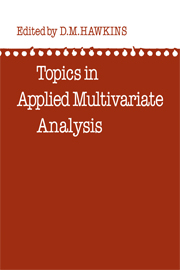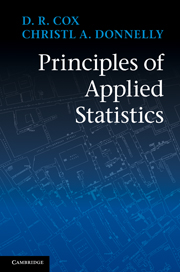Refine search
Actions for selected content:
2348 results in Statistical theory and methods
B - Some Basic Tools
-
- Book:
- Regression for Categorical Data
- Published online:
- 05 June 2012
- Print publication:
- 21 November 2011, pp 490-495
-
- Chapter
- Export citation
4 - Modeling of Binary Data
-
- Book:
- Regression for Categorical Data
- Published online:
- 05 June 2012
- Print publication:
- 21 November 2011, pp 81-122
-
- Chapter
- Export citation
10 - Semi- and Non-Parametric Generalized Regression
-
- Book:
- Regression for Categorical Data
- Published online:
- 05 June 2012
- Print publication:
- 21 November 2011, pp 269-316
-
- Chapter
- Export citation
C - Constrained Estimation
-
- Book:
- Regression for Categorical Data
- Published online:
- 05 June 2012
- Print publication:
- 21 November 2011, pp 496-499
-
- Chapter
- Export citation
8 - Multinomial Response Models
-
- Book:
- Regression for Categorical Data
- Published online:
- 05 June 2012
- Print publication:
- 21 November 2011, pp 207-240
-
- Chapter
- Export citation
D - Kullback-Leibler Distance and Information-Based Criteria of Model Fit
-
- Book:
- Regression for Categorical Data
- Published online:
- 05 June 2012
- Print publication:
- 21 November 2011, pp 500-503
-
- Chapter
- Export citation
Frontmatter
-
- Book:
- Regression for Categorical Data
- Published online:
- 05 June 2012
- Print publication:
- 21 November 2011, pp i-iv
-
- Chapter
- Export citation
12 - The Analysis of Contingency Tables: Log-Linear and Graphical Models
-
- Book:
- Regression for Categorical Data
- Published online:
- 05 June 2012
- Print publication:
- 21 November 2011, pp 331-362
-
- Chapter
- Export citation
E - Numerical Integration and Tools for Random Effects Modeling
-
- Book:
- Regression for Categorical Data
- Published online:
- 05 June 2012
- Print publication:
- 21 November 2011, pp 504-508
-
- Chapter
- Export citation
Author Index
-
- Book:
- Regression for Categorical Data
- Published online:
- 05 June 2012
- Print publication:
- 21 November 2011, pp 545-553
-
- Chapter
- Export citation
Preface
-
- Book:
- Regression for Categorical Data
- Published online:
- 05 June 2012
- Print publication:
- 21 November 2011, pp ix-x
-
- Chapter
- Export citation

Topics in Applied Multivariate Analysis
-
- Published online:
- 05 November 2011
- Print publication:
- 22 April 1982

Principles of Applied Statistics
-
- Published online:
- 07 September 2011
- Print publication:
- 28 July 2011
10 - Epilogue
-
- Book:
- Principles of Applied Statistics
- Published online:
- 07 September 2011
- Print publication:
- 28 July 2011, pp 184-188
-
- Chapter
- Export citation
2 - Design of studies
-
- Book:
- Principles of Applied Statistics
- Published online:
- 07 September 2011
- Print publication:
- 28 July 2011, pp 14-28
-
- Chapter
- Export citation
3 - Special types of study
-
- Book:
- Principles of Applied Statistics
- Published online:
- 07 September 2011
- Print publication:
- 28 July 2011, pp 29-52
-
- Chapter
- Export citation
Contents
-
- Book:
- Principles of Applied Statistics
- Published online:
- 07 September 2011
- Print publication:
- 28 July 2011, pp v-viii
-
- Chapter
- Export citation
9 - Interpretation
-
- Book:
- Principles of Applied Statistics
- Published online:
- 07 September 2011
- Print publication:
- 28 July 2011, pp 159-183
-
- Chapter
- Export citation
1 - Some general concepts
-
- Book:
- Principles of Applied Statistics
- Published online:
- 07 September 2011
- Print publication:
- 28 July 2011, pp 1-13
-
- Chapter
- Export citation
7 - Model choice
-
- Book:
- Principles of Applied Statistics
- Published online:
- 07 September 2011
- Print publication:
- 28 July 2011, pp 118-139
-
- Chapter
- Export citation
